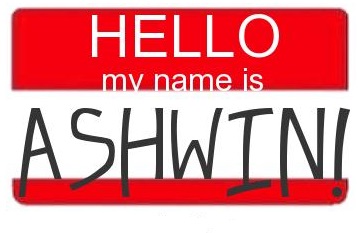 Every time I am introduced to someone new, I say my name and pause, waiting for the furrowed brow and inevitable question: how do you pronounce that? My name, Ashwin, is a source of deep pride, but remains an inescapable marker of otherness.
Every time I am introduced to someone new, I say my name and pause, waiting for the furrowed brow and inevitable question: how do you pronounce that? My name, Ashwin, is a source of deep pride, but remains an inescapable marker of otherness.
The “Starbucks name” is now a well-documented phenomenon, but I grew up in a household that took things a little further. Jogesh was reduced to Jay, Nikhil shrunk to Nik and Menaka occasionally transformed to Monica whenever my mother lost patience and gave in to the telemarketers. My parents explained this as a necessary sacrifice, part of the give and take that comes with assimilating in America.
For many years, I believed them. I introduced myself as Ashwin [pullquote]I used the pronunciation of my name as a wedge, the “correct” pronunciation reserved for family and close friends, a marker of intimacy.[/pullquote]with a hard “a,” and feigned indifference when people asked if I had a preference. I used the pronunciation of my name as a wedge, the “correct” pronunciation reserved for family and close friends, a marker of intimacy. That quickly faded after spending a year in India, surrounded by 1.2 billion strangers who could pronounce my name flawlessly.
Today, I am less certain that mispronounced names are simply part of the immigrant way of life. For my parents, part of a diaspora wave during the late 1970s, community was insular and grew among their fellow immigrants, though it remained fractured along religious, ethnic, and linguistic lines. Solidarity formed in the shared experience of exploring and assimilating (or not) in a new and unfamiliar land. Safety could always be found in a neighbor or coworker who understood where you came from because he or she came from the same place.
The South Asian Americans of my generation are anything but strangers to this country. We were born in the United States, raised in the American cultural milieu, and maintain unique identities, often as Americans first and South Asians second. Our nascent community is still growing, stretching its boundaries and finding its feet, but it has every reason to assert its place.
Between 2000 and 2010, the South Asian population grew 81 percent to 3.4 million, and our presence is predicted to only get larger. It’s not just South Asians. According to the Pew Research Center, 93 percent of the growth of our country’s working-age population between now and 2050 will come from immigrants and their U.S.-born children. 2043 is the year identified by the U.S. Census bureau in which whites will no longer be the majority in this country.
It is more than just a numbers game, however. When I think of the identity of the South Asians of my generation, I think first of the sacrifice of those who came before us, of those that fought to make our lives in this country permanent. Today, we are here to stay, our destiny and geography inexorably linked. [pullquote]My name is not a stumbling block, but an opportunity for dialogue and a chance to affirm my identity.[/pullquote]We seek to stake a place in this country and have our voices heard.
For me, that starts at “hello.” My name is not a stumbling block, but an opportunity for dialogue and a chance to affirm my identity. It is a small but vital step as I continue to grapple with the question of what it means to be a South Asian American today.
* * *
Ashwin Warrior lives in the California Bay Area and works in non-profit communications, promoting social good and supporting progressive causes and organizations. You can follow him on Twitter at @ashwinwarrior and see other things he’s written here.













2 thoughts on “Dialogue, Identity and ‘How Do You Pronounce That?’”
Comments are closed.